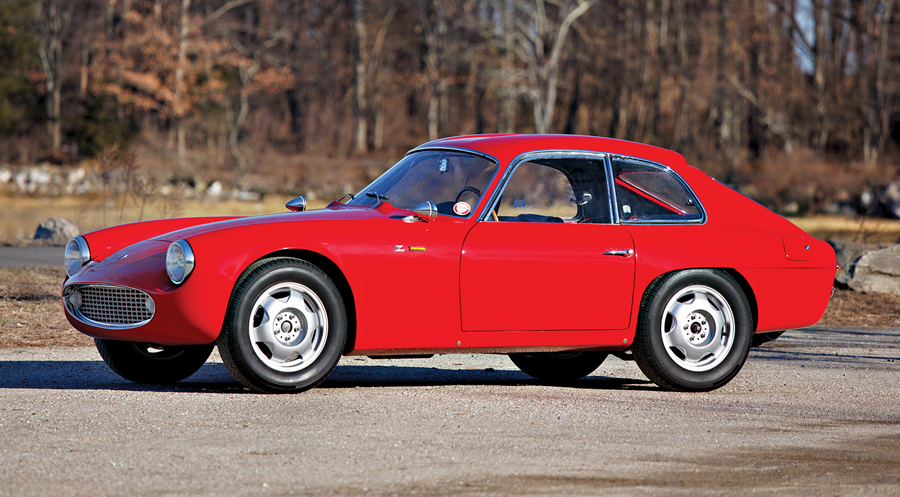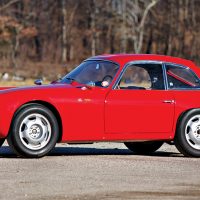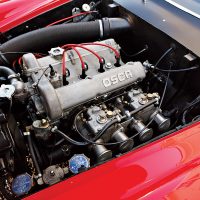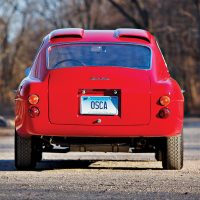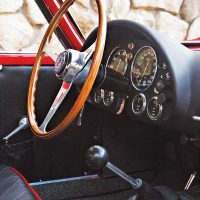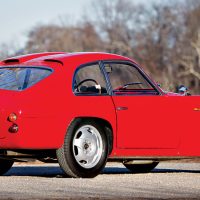The car offered here, chassis 006, is an early example of these limited-production coupes and is one of approximately 100 Zagato-bodied cars that were slated to be produced. Designed by the legendary Ercole Spada, the construction utilized hand-formed lightweight alloy coachwork over a tube-frame assembly. Its iconic “double-bubble” roofline is both distinctive and functional, providing extra headroom for taller drivers while incorporating air extractors to shed cabin heat during racing conditions.
SCM Analysis
Detailing
| Vehicle: | 1961 OSCA 1600 GT |
| Years Produced: | 1960–65 |
| Number Produced: | 128 (all coachbuilt cars) |
| Original List Price: | $7,000 |
| SCM Valuation: | $341,000 |
| Chassis Number Location: | By right front suspension pickup point |
| Engine Number Location: | Right rear of block |
| Club Info: | Maserati Club International |
| Website: | http://www.maseratinet.com |
| Alternatives: | 1960 Alfa Romeo SZ, 1960 Porsche Abarth, 1964 ASA 1000 GT |
| Investment Grade: | B |
This car, Lot 13, sold for $489,000, including buyer’s premium, at Gooding & Company’s Amelia Island, FL, sale on March 8, 2019.
Not surprisingly, I paid a great deal of attention to this car when I saw it at the Gooding & Company preview at Amelia Island.
I have long had a passion for all OSCA cars — especially these fantastic pocket GTs, which are the swan song in the story the Maserati brothers began so many decades before. That I admire and appreciate race cars but establish long-term relationships with their road-going cousins also brings me closer to our subject.
OSCA 1600 auction histories
I wrote a profile on a Zagato-bodied 1965 OSCA 1600 GT 12 years ago (SCM January 2007, p. 54). The car sold at the Sportscar Auction in Geneva, Switzerland, in October 2006. Chassis 0099 sold for $168,800 on that occasion, nearly twice as much as it had sold for in 2002 at RM Auctions’ Monterey sale in August 2002.
My colleague Thor Thorson wrote a profile of a 1964 1600 GT Zagato in the December 2016 issue of SCM (Race Profile, p. 84). His subject, chassis 011, was one of the few OSCA 1600 GTs to have a successful career in competition when new. At the Bonhams Chantilly sale in France on September 2016, the car was a post-block sale at the U.S. dollars equivalent of $328,327. That was reported to be less than the seller had paid for the car a few years earlier.
That car from the December 2016 issue appeared in the photographs to be finished to a very good, correct and authentic level, with lightweight Zagato racing seats, reproduction aluminum Amadori wheels and reproduction hubcaps.
Many varieties
OSCA offered a wide range of 1600 models. They included a street-version 95-hp GT with a single Weber 36 DCLDE carb, open headlights and bumpers. There was a 125-hp, twin-Weber 38 DCOE carb GT2 car. There was also the 145-hp GTV, sporting twin Weber 42 DCOEs with no bumpers and covered headlights.
These days, these cars are all referred to as a “1600 GT” for the sake of simplicity.
Our subject is the last of them — the hi-po version for street or track.
As is often the case with low-production Italian cars, our subject car has open headlights, no bumpers and the hot engine. Any customer could have configured his car any way they wished. It’s also interesting that Zagato-bodied 1600 GT cars are the most common.
The number built in total has never been nailed down, but it is doubtless lower than the figure shared by OSCA itself, which is 128.
My all-time favorite OSCA 1600 GTs are the two coupes from Carrozzeria Touring. I also like the largely ignored Carrozzeria Fissore examples, of which about 14 were made. That the 1600 GT is the rich, fancy cousin to my beloved Fiat 1500 OSCA Pinin Farina coupe also helps make me a fan of the car.
Built to drive hard
The subject car was well presented. It was clearly intended for driving on rallies and tour events. The level of fit and finish was more than acceptable, and it wore Amadori-style wheels without hubcaps.
Inside we could see a former owner’s interpretation of what Zagato might have done for a car for town and country — rather than track and hillclimb.
In a curious mixture, a pair of richly upholstered Zagato racing seats shared space with elaborately padded and quilted central tunnel trim and fully carpeted floors. This doesn’t represent what most often emerged from Zagato’s shop in period. However, I would much prefer this more habitable environment for a weeklong, 1,000-mile rally today.
Comfort or competition?
Our subject OSCA is an example of how decisions are sometimes made on how we restore cars. The potential conflict between historical accuracy and the owner experience will only grow as collecting becomes more sophisticated and matures.
This is especially true when it comes to these 1960s GT cars — the last of the true dual-purpose “drive to the track and drive home” vehicles. There is no single way to restore them, yet decisions must be made and they should be defensible.
We have to find the way to be true to our cars while also being true to the builders’ intent. This car falls somewhere between two stools.
Well sold — but worth it
As many people saw me in and around the car during the preview, I was often asked where I thought it would sell.
After giving my normal response about the vagaries of the auction sale room and the admonishment that my crystal ball was still in the restoration shop awaiting parts, I opined that it would probably sell in the middle of the $350,000–$500,000 estimate range.
In the end, bidder enthusiasm drove it near the high estimate. Given the rarity of the model and its eminent usability, I would tote this in the well sold — but not inappropriately bought — column.
If a truly superb — and more historically consistent — car were to appear on the market, it could bring another 30%. ♦
(Introductory description courtesy of Gooding & Company.)
